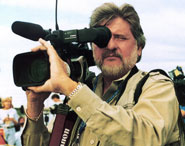 |
→ June 2005 Contents → Column
|
Welcome to the June issue of The Digital Journalist, the monthly online magazine for visual journalism.
Paparazzi, to many, represent the dark side of photojournalism. It could be argued that they really aren't even photojournalists. But the simple fact is that more readers see their pictures than any other kind of photography. What do you say about a photographer who spent $16,000 a day to hire a submarine so he could stalk Princess Diana? Executive Editor Peter Howe has just published "Paparazzi," a book that takes a look at what makes them tick, and how they pull it off. We present selections from his book as our cover feature in this issue.
In October 1966 a mountain fell on the Welsh town of Aberfan, killing 116 children and 28 adults. It was the ultimate environmental horror. A hill-sized mound of black slag, excavated from a coal mine, had moved after being soaked from below by hidden springs and drenched by autumn rains. Photographer Chuck Rapoport chronicled the results of the disaster in human terms. He recently mounted an exhibition in Wales that stands as a stark reminder of what can happen if environmental concerns are not taken into account.
On April 30th, 1975, Communist tanks crashed through the gates of the Presidential Palace in Saigon, ending a 15-year war with America. Thirty years later, the photographers and reporters who covered the conflict returned to Ho Chi Minh City to revisit this pivotal chapter of their lives. We have created a special section in this month's issue to tell their stories. Some of the photographers who returned then went on to Hanoi to conduct a workshop for young Vietnamese photojournalists. We report on this workshop in the "Vietnam" section. Hugh Van Es recounts what happened the day he made the iconic photo of people clambering aboard one of the last helicopters to leave Saigon. We also recommend that those of you with broadband spend 15 minutes to watch the phenomenal interview with a legend of photography, Tim Page, who has the dubious honor of being probably the most often wounded newsman to cover the war. I promise you, it is a hair-raising tale.
On the first day of the Hanoi workshop, our Editor for Europe, Horst Faas, who organized both the reunion and the master class, was stricken by a blood clot that attached itself to his spinal column. He nearly died in a Hanoi hospital, but the doctors managed to stabilize him and get him medevaced to Bangkok. However, he was paralyzed from the chest down. Since then, Horst has been moved to Bavaria, where his first act was to have a German beer. He can read e-mail, so if you would like to send him your good wishes, you can at HorstFaas@compuserve.com.
In this issue, we have commentaries by Tom Hubbard and Ron Steinman. Brian Storm writes about why photojournalists need to add a DAT recorder to their bag. Bill Pierce's "Nuts and Bolts," Terry Heaton's "TV In The Postmodern Age," Jim Colburn's "Letter From Central America," Mark Loundy's "Common Cents," Chuck Westfall's "Tech Tips," and an ethics column by Eric Ugland and Karen Slattery all round out the June issue with a variety of viewpoints.
Three photojournalists sent Dispatches this month from the corners of the world. Monica Almeida, assigned by The New York Times to cover arrivals at the Michael Jackson trial, took a look at the characters outside the courthouse. Darren McCollester visited Myanmar, a country that does not welcome photojournalists, entering the former Burma as a "tourist" who packed "one pair of pants, 2 shirts, one pair of socks, and a rather large-looking professional D1x camera, two lenses, and a dozen flash cards." Dana Smillie, a freelance photojournalist living in Cairo, thought she knew the drill when demonstrations over upcoming elections were expected. As riot police stepped aside, it got ugly and personal for journalists, especially women like Dana. These experiences - overcoming the mundane, working outside one's normal identity, being attacked on assignment - are detailed in this month's Dispatches.
This month, "E-Bits" editor Beverly Spicer explores the world of imagination, presenting stunning photos of living spaces in China, a video of a literal flight of fancy, and cloud formations few of us have ever seen.
There are two journals in "Assignment Sheet" this month and they should have something for everyone. "A Photo an Hour" continues the thread started last month by photojournalism student Joyce Lin. As a new entrant to a highly competitive field, Joyce questions her abilities, techniques and her ambitions. This should ring familiar with any of us who have been in the business for any length of time. And that is why the editor of "Assignment Sheet," an old fossil of a news photographer, has written an Editor's Note as an addendum to this fine journal. Then, that same old fossil, Dick Kraus, has included another story out of the pages of Damon Runyon with his "Through a Lens Dimly" recollection of a colorful co-worker, entitled "Super Ernie."
And don't miss reading about former AP and U.S. News & World Report photographer Chick Harrity's well-earned Lifetime Achievement Award, presented by the White House News Photographers' Association – with a poignant twist – in "A Surprise From Long Ago and Far Away."
Finally, our summer Platypus Workshop is accepting applications at the Maine Photo Workshop, and our Advanced Platypus Workshop is taking registrations at the Brooks Institute of Photography. If you are in the growing numbers of photojournalist and editors who are in the midst of transferring to convergence, or want to enter HDDV filmmaking, these workshops are for you.
We hope you enjoy this issue. Don't hesitate to send e-mails to our contributors.
Dirck Halstead Dirck Halstead
| ||||||
